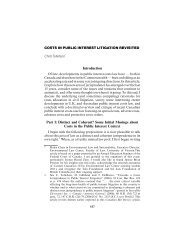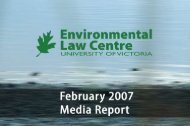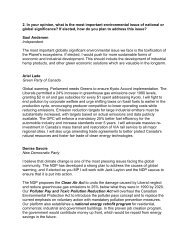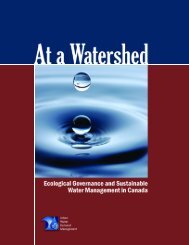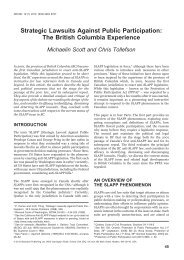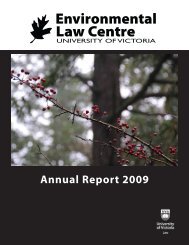Peeling back the Pavement - POLIS Water Sustainability Project
Peeling back the Pavement - POLIS Water Sustainability Project
Peeling back the Pavement - POLIS Water Sustainability Project
You also want an ePaper? Increase the reach of your titles
YUMPU automatically turns print PDFs into web optimized ePapers that Google loves.
25. Podolsky, L. (2005); see also U.S. Environmental Protection Agency. (2008, December). Managing<br />
Wet Wea<strong>the</strong>r with Green Infrastructure Municipal Handbook: Green Infrastructure Retrofit Policies.<br />
Retrieved from http://www.epa.gov/npdes/pubs/gi_munichandbook_retrofits.pdf<br />
26. See U.S. Environmental Protection Agency. (2009). Green Infrastructure Pennsylvania: Philadelphia. Retrieved<br />
from http://cfpub.epa.gov/npdes/greeninfrastructure/gicasestudies_specific.cfm?case_id=62<br />
27. See Duhigg, C. (2009, November 22). As Sewers Fill, Waste Poisons <strong>Water</strong>ways. The New York Times.<br />
Retrieved from http://www.nytimes.com/2009/11/23/us/23sewer.html?pagewanted=all<br />
28. City of Toronto. (2011). Wet Wea<strong>the</strong>r Flow Master Plan (WWFMP). Retrieved from http://www.<br />
toronto.ca/water/protecting_quality/wwfmmp/index.htm<br />
29. Mirza, S. (2007)<br />
30. See Florida Stormwater Association. (2003). Establishing a Stormwater Utility in Florida. Retrieved<br />
from www.florida-stormwater.org/content.asp?pl=8&contentid=33<br />
31. U.S. Environmental Protection Agency. (2008).<br />
32. Cited in Design Centre for <strong>Sustainability</strong> at UBC, & Brandes, O. M. (2006, April). Smart Growth on <strong>the</strong><br />
Ground Foundation Research Bulletin: Greater Oliver. Vancouver, Canada: Design Centre for <strong>Sustainability</strong><br />
at <strong>the</strong> University of British Columbia. Retrieved from http://poliswaterproject.org/sites/default/<br />
files/_OlFRB_<strong>Water</strong>Conservation.pdf<br />
33. Farahbakhsh, K., Despins, C., & Leidl, C. (2009). Developing Capacity for Large-Scale Rainwater Harvesting<br />
in Canada. <strong>Water</strong> Quality Resource Journal of Canada, 44, 92-102; xeriscaping is environmental<br />
design, landscaping, and use of native plants to minimize <strong>the</strong> need for water use.<br />
34. Waffle, C., Barrett-Wood, Z., Maas, C., & Alfred, E.J. (2009, November). Rainwater Harvesting: An<br />
Untapped Opportunity for Ontario. Paper presented at New Directions ’09 in Stormwater Management.<br />
Symposium conducted at meeting of Sustainable Technologies Evaluation Program in Ontario.<br />
35. RiverSides. Rainwater Harvesting in Toronto: Potential Energy Conservation & Greenhouse Gas Emission<br />
Reductions–An Analysis of Benefits & Implementation Barriers. Prepared for <strong>the</strong> Toronto Atmospheric<br />
Fund. Revised June 2010. Retrieved from www.riversides.org/websitefiles/RwH_Essay_for_HTO.<br />
pdf; see also Maas, C. (2009). Greenhouse Gas and Energy Co-Benefits of <strong>Water</strong> Conservation. Victoria,<br />
Canada: <strong>POLIS</strong> <strong>Project</strong> on Ecological Governance at <strong>the</strong> University of Victoria. Retrieved from http://<br />
poliswaterproject.org/publication/91; see also Waffle, et al. (2009).<br />
36. Coombes, P. J., Kuczera, G., Kalma, J. D., & Argue, J. (2002). An evaluation of <strong>the</strong> benefits of source<br />
control measures at <strong>the</strong> regional scale. Urban <strong>Water</strong>, 4(4), 307. Retrieved from http://www.urbanwater.<br />
net; Coombes, P. J., & Kuczera, G. (2003, November). Analysis of <strong>the</strong> Performance of Rainwater Tanks<br />
in Australian Capital Cities. Paper presented at <strong>the</strong> 28th International Hydrology and <strong>Water</strong> Resources<br />
Symposium. Symposium conducted at meeting of <strong>the</strong> Institution of Engineers, Australia in Wollongong,<br />
NSW. Retrieved from www.enviro-friendly.com/water-tank-performance.pdf<br />
37. Royal Society of Chemistry. (2007). Sustainable <strong>Water</strong>: Chemical Science Priorities Summary Report.<br />
Retrieved from www.rsc.org/images/waterreport_tcm18-108403.pdf<br />
38. Cited in BC Ministry of <strong>Water</strong>, Land and Air Protection (2002, May). Stormwater Planning: A Guidebook<br />
for British Columbia. Retrieved from www.env.gov.bc.ca/epd/epdpa/mpp/stormwater/guidebook/pdfs/<br />
stormwater.pdf; see also Forasté J. A., & Hirschman, D. (2010, April). A Methodology for Using Rainwater<br />
Harvesting as a Stormwater Management BMP. In Low Impact Development 2010: Redefining <strong>Water</strong> in <strong>the</strong><br />
City–Proceedings of <strong>the</strong> 2010 International Low Impact Development Conference (pp. 31-44). Retrieved<br />
from http://ascelibrary.org/proceedings/resource/2/ascecp/367/41099/4_1?isAuthorized=no<br />
39. Farahbakhsh et al. (2009). A study in British Columbia showed that RWH systems with more than<br />
100 cubic metres of storage capacity per hectare of rooftop, for densities of 175 to 350 dwelling units<br />
per hectare, that provided water for toilets and washing machines reduced <strong>the</strong> total volume of runoff<br />
from residential lots by almost 90 per cent when used with <strong>the</strong> <strong>Water</strong> Balance Model—BC Ministry of<br />
<strong>Water</strong>, Land and Air Protection (2002).<br />
40. Waffle, et al. (2009).<br />
63



